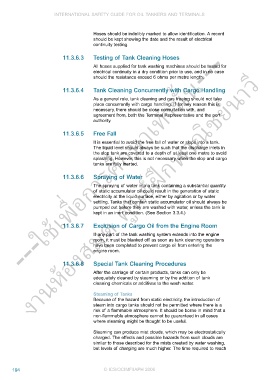Page 228 - International safety guide for oil tankers and terminals
P. 228
INTERNATIONAL SAFETY GUIDE FOR OIL TANKERS AND TERMINALS
Hoses should be indelibly marked to allow identification. A record
should be kept showing the date and the result of electrical
---ใช้เพื่อการศึกษาเท่านั้น---
continuity testing.
11.3.6.3 Testing of Tank Cleaning Hoses
งานห้องสมุด ศูนย์ฝกพาณิชย์นาวี
All hoses supplied for tank washing machines should be tested for
electrical continuity in a dry condition prior to use, and in no case
should the resistance exceed 6 ohms per metre length.
11.3.6.4 Tank Cleaning Concurrently with Cargo Handling
As a general rule, tank cleaning and gas freeing should not take
place concurrently with cargo handling. If for any reason this is
necessary, there should be close consultation with, and
agreement from, both the Terminal Representative and the port
authority.
11.3.6.5 Free Fall
It is essential to avoid the free fall of water or slops into a tank.
The liquid level should always be such that the discharge inlets in
the slop tank are covered to a depth of at least one metre to avoid
splashing. However, this is not necessary when the slop and cargo
ึ
tanks are fully inerted.
11.3.6.6 Spraying of Water
The spraying of water into a tank containing a substantial quantity
of static accumulator oil could result in the generation of static
electricity at the liquid surface, either by agitation or by water
settling. Tanks that contain static accumulator oil should always be
pumped out before they are washed with water, unless the tank is
kept in an inert condition. (See Section 3.3.4.)
11.3.6.7 Exclusion of Cargo Oil from the Engine Room
If any part of the tank washing system extends into the engine
room, it must be blanked off as soon as tank cleaning operations
have been completed to prevent cargo oil from entering the
engine room.
11.3.6.8 Special Tank Cleaning Procedures
After the carriage of certain products, tanks can only be
adequately cleaned by steaming or by the addition of tank
cleaning chemicals or additives to the wash water.
Steaming of Tanks
Because of the hazard from static electricity, the introduction of
steam into cargo tanks should not be permitted where there is a
risk of a flammable atmosphere. It should be borne in mind that a
non-flammable atmosphere cannot be guaranteed in all cases
where steaming might be thought to be useful.
Steaming can produce mist clouds, which may be electrostatically
charged. The effects and possible hazards from such clouds are
similar to those described for the mists created by water washing,
but levels of charging are much higher. The time required to reach
194 © ICS/OCIMF/IAPH 2006

